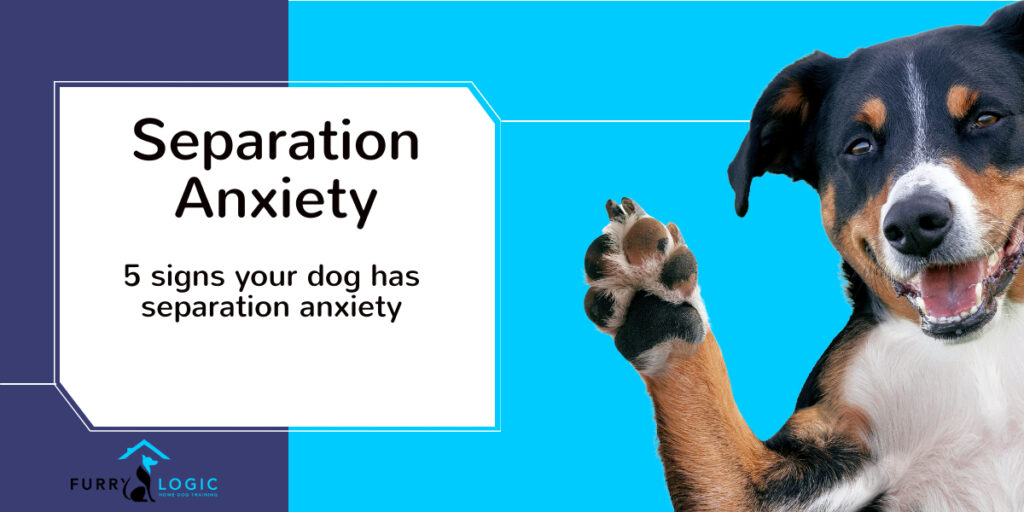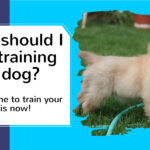Changing your behaviour can relieve your dog of his anxiety
-Furry Logic Home Dog Training

5 signs your dog has separation anxiety
- She follows you everywhere like a two-year old child, even to the bathroom. And if you want some privacy and you close the door behind you, she scratches and whines to get in.
- Your dog chews on things that have your scent, things that you handle a lot like your TV remote control, your favorite pen, your glasses, maybe even your underwear. It’s not because they taste good, it’s to relieve their anxiety when you’re not around. Think of a pacifier or human nail-biting. Chewing relieves stress.
- He’s fine in his kennel until he can’t see you from there anymore. Then he starts clawing at the door, barking or howling, or tearing up his bed.
- If he’s not kenneled, he lies by the door until you return and when you come home, he acts as if he can’t believe you’re still alive, jumping up on you and/or barking as if he thought you were never coming back. Even if you just took the garbage out, even if he can watch you from the window.
- She toilets in the house while you’re gone when you know she is perfectly house-trained.
The Mayo Clinic describes Separation Anxiety Disorder in humans. Amongst the many signs:
Although our dogs cannot tell us what they are thinking, their behaviour certainly points to this way of thinking.
With this in mind, we have found that building a dog’s confidence in his owner leads to an all-around more confident dog who trusts that his owner has the chops to be able to find her way home and even bring dinner too!
We talked earlier in a previous blog post, about how pups needn’t panic when Mom leaves the whelping box or den. Of course Mom is the boss!
Confidence leads to Trust
We find that owners who let their dog structure how they live their lives, are the ones whose dog suffers the most from sep anx. What do we mean by this?
The dog’s experience is “I am the most important one in this relationship”. When I demand anything, a walk, to be let out, to be fed, to be given a treat, to be played with, etc., I get it. You might ask, “Well isn’t it cruel to not respond to my dog’s request?” The short answer is “No”.
All of these are Wants, not Needs. And although it probably gives you pleasure to respond immediately, a dog who suffers from separation anxiety will do well to experience delayed gratification. How long should the delay be? Pretend you are doing something more important, and when your dog loses interest, make the walk or dinner your idea, “on your own time’. It’s not the hard No that you fear but more “Yes, when I’m ready and I’ll be ready in a little bit.”
People ask us what’s the best schedule for my dog? In the very beginning, Puppy needs a schedule to assist with house training. But once a puppy is confidently house trained, you should start mixing the schedule up. When you do, your dog becomes more adaptable to the things that life throws at them.
Nobody died because dinner was an hour late. No dog went feral because there was a 24-hour blizzard and going for a walk became out of the question.
2 examples of how scheduling is a human need, not a dog’s need
We have seen clients arrive super stressed for an after-work lesson because they got caught in traffic and they thought their dog needed a walk as soon as they got home. OMG! Sweat pouring off their brow. Oh no, now there was no time! Honestly, the client was the one who was most upset. The dog was fine.
Another client was dead set on feeding his German Shepherd at 4:30 every day. His wife said they would be having a lovely time with friends and all of a sudden, they had to leave to feed the dog. We saw this in action, when during the lesson, 4:30 arrived and he wanted to stop everything to feed the dog. We asked if he couldn’t wait a few minutes because we were almost finished with the training session. Our client got up, marched into the garage and audibly slammed the door behind himself. We finished up with the wife and the dog, who were visibly enjoying the training and were attentive throughout. None the worse for wear.
People who live alone with their dog and make their dog their priority over themselves, are our most common client reporting separation anxiety in their dog. The dog senses its elevated importance and even though it may not be suitable to lead, sees weakness in its owner. “If my owner is weak, then anything could happen to her if I let her out of my sight.”
“I must call her back” which leads to barking and/or howling. Or “I must escape to find her” which leads to damage to property like claw marks or chewed holes in the door or adjacent dry wall, bite marks on the doorknobs, destroyed Venetian blinds or even a broken window in one case.
Much of our work results from complaints from neighbouring apartments or building superintendents about the barking during the day. The person seeking help is in danger of being evicted or even, losing their dog.
A case study where we failed
We were hired by an elderly couple whose Bichon/Shih Tzu had strong separation anxiety. They lived in a mobile home park, so neighbours were only a few feet away. The neighbours had been complaining about the barking and they needed to fix it.
We soon discovered that Luna could never be left alone, anywhere. These lovely people had adapted their lives to their dog’s anxiety, so whenever they wanted to have restaurant food, they would order take-out, drive over and one person would go in , while the other sat with the dog in the car. Then the ritual was that the dog got the first bite. As long as they had had the dog, they never went into a restaurant together to have a nice dinner without Luna.
So imagine when we tried to get them to make some changes at home to teach Luna that she didn’t rule their every action. With all our persuasive powers and gentle explanations,(we even spoke to her in French as it was her first language) they absolutely would not believe that the barking problem was rooted in their fear of hurting the dog’s feelings. They believed that being good dog parents meant giving her whatever she wanted whenever she wanted it. And they were convinced that Luna’s anxiety was from fear of being alone not, as we tried to explain, fear that they would perish without her constant supervision.
Let’s look at Separation Anxiety another way
Maybe you think it’s cute, maybe not. You have a friend who is constantly checking up on you.
“Who are you texting?”
“Who are you talking to?”
“What are you eating? “
“Where are you going? I’m going with you.”
Now imagine that it’s your dog who is doing the talking. Not so cute anymore, huh? This is how separation anxiety shows itself. It’s a control behaviour.
It’s not the fear of being alone. It’s the need to control someone’s life due to the belief that that person is incapable. Which is why the anxiety is most obvious when your dog is left at home without you.
How can a mere dog develop these kinds of “feelings”? It’s easy when you let the dog lead the way both literally and by response. Literally – Out for a walk, dog is in front; dog wants to stop and sniff, owner waits as long as it takes for the dog to lose interest. Dog wants to go home, they go home.
By response – Dog wants to go outside to bark at the neighbour, owner jumps up to open the door. Dog jumps on the counter to see what he can get, owner rewards him with a snack. Dog manages the front door by barking and jumping up on whoever arrives there, owner tells Visitor it’s their fault if they don’t like how their dog greets them. Dog sleeps on owner’s bed to watch over him during the night, owner gives silent approval by not objecting.
Result: When a dog gets what it wants, when it wants it, we let the dog know that it is the boss of us.
When a dog thinks that it is in charge, it will understand that its job is to make decisions for the survival of the group. In the grand scheme of things, the 2 most important things to a dog are, (in order of importance): food and leadership. (We discuss good quality food for your dog in another blog post.)
Leadership – the 2nd most important thing to a dog
Of the 5 things that every dog needs for a long and healthy life, Leadership stands at No. 2. The social group needs a leader to protect the weak in the group and keep everyone in order. If the owner doesn’t set any rules and/or boundaries (the behaviour of a leader), “Then the burden falls on me,” says Rover. “I must step up for the well-being of the group.” Unfortunately, Rover doesn’t understand the needs of living in human society so he behaves in ways that cause trouble for him and his human.
In conclusion, we hope this discussion has helped you to understand how we get from
- The Signs of Separation Anxiety in our dog to =>
- Observing how our behaviour misinforms him into thinking that he’s our boss to =>
- A realization that changing our behaviour can relieve him of his anxiety.
Please contact us to learn more about how we can help you and your dog or to book your first lesson.
.







No comment yet, add your voice below!